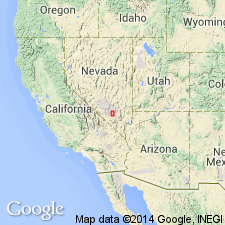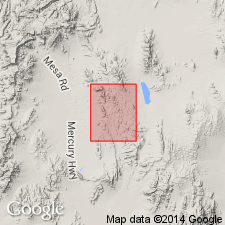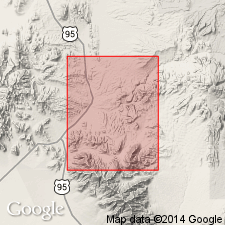
- Usage in publication:
-
- Ranger Mountains member*
- Modifications:
-
- Original reference
- Dominant lithology:
-
- Limestone
- AAPG geologic province:
-
- Great Basin province
Summary:
Pg. C108, C110 (fig. 189.1). Ranger Mountains member of Antelope Valley limestone of Pogonip group. Middle member of Antelope Valley limestone; underlies Aysees member and overlies Paiute Ridge member (both new). Ledge-forming, olive-gray, thin-bedded, silty limestone, mottled yellow and red along silty layers. Abundant fossils [listed]; contains a thin-bedded brachiopod-bearing limestone in upper 50 feet. Thickness 215 feet. (=unit G of Johnson and Hibbard, 1957, USGS Bull. 1021-K.) Age is Early and Middle Ordovician.
Type locality: Ranger Mountains, [approx. Lat. 36 deg. 45 min. 30 sec. N., Long. 115 deg. 51 min. 00 sec. W., along southern edge Frenchman Lake 15-min quadrangle (Frenchman Flat quadrangle)], Clark Co., southern NV.
Aysees Peak measured section (loc. 2), [Buried Hills area, approx. Lat. 36 deg. 52 min. 30 sec. N., Long. 115 deg. 48 min. 52 sec. W., eastern central Frenchman Lake 15-min quadrangle (Frenchman Flat quadrangle), Las Vegas Bombing and Gunnery Range / Desert National Wilderness Range, Lincoln Co., southern NV].
[Additional locality information from USGS GNIS database and USGS historical topographic map collection TopoView, accessed Memorial Day, 2018.]
Source: Publication; US geologic names lexicon (USGS Bull. 1350, p. 615).

- Usage in publication:
-
- Ranger Mountains Member*
- Modifications:
-
- Mapped
- Dominant lithology:
-
- Limestone
- AAPG geologic province:
-
- Great Basin province
Summary:
Ranger Mountains Member of Antelope Valley Limestone of Pogonip Group. Mapped in Nye County, Nevada, where it is 215 feet thick. Consists of olive-gray, thin-bedded, silty limestone, mottled yellow and red along silty layers. Brachiopods and other fossils abundant in upper 50 feet. Overlies Paiute Ridge Member; underlies Aysees Member (both of Antelope Valley Limestone). Age is Early and Middle Ordovician.
Source: Publication; US geologic names lexicon (USGS Bull. 1350, p. 615).

- Usage in publication:
-
- Ranger Mountains Member*
- Modifications:
-
- Age modified
- Biostratigraphic dating
- AAPG geologic province:
-
- Great Basin province
Summary:
Ranger Mountains Member of Antelope Valley Limestone. Recognized in southern Nevada. Age changed from Early and Middle Ordovician --to-- Middle Ordovician, based on studies of mudmounds with STROMATACTIS structures.
Source: GNU records (USGS DDS-6; Menlo GNULEX); Changes in stratigraphic nomenclature, 1975 (USGS Bull. 1422-A, p. A32-A33).
For more information, please contact Nancy Stamm, Geologic Names Committee Secretary.
Asterisk (*) indicates published by U.S. Geological Survey authors.
"No current usage" (†) implies that a name has been abandoned or has fallen into disuse. Former usage and, if known, replacement name given in parentheses ( ).
Slash (/) indicates name conflicts with nomenclatural guidelines (CSN, 1933; ACSN, 1961, 1970; NACSN, 1983, 2005, 2021). May be explained within brackets ([ ]).

